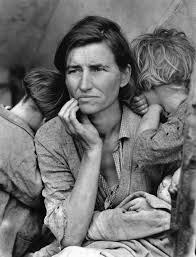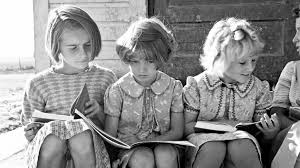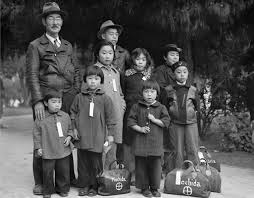 May 26th, 1895 was the birthday of documentary photographer Dorothea Lange. She was born Dorothea Nutzhorn in Hoboken, New Jersey, in 1895, and is best known for her Depression-era work for the Farm Security Administration. Her most famous photo was “Migrant Mother” (left) in 1936, but took many more that were just as hauntingly beautiful. Many (like these examples) are on Google Images.
May 26th, 1895 was the birthday of documentary photographer Dorothea Lange. She was born Dorothea Nutzhorn in Hoboken, New Jersey, in 1895, and is best known for her Depression-era work for the Farm Security Administration. Her most famous photo was “Migrant Mother” (left) in 1936, but took many more that were just as hauntingly beautiful. Many (like these examples) are on Google Images.
Here is The Writer’s Almanac entry about Dorothea (http://writersalmanac.org/page/8/ ) —
She contracted polio when she was seven, and her left leg was noticeably weaker than her right for the rest of her life. She came to see that as a kind of blessing: “[It] was the most important thing that happened to me, and formed me, guided me, instructed me, helped me, and humiliated me,” she said. Her father abandoned the family, and her parents divorced, when Dorothea was 12. She had a lot of anger toward her father as a result, and she changed her name, dropping the Nutzhorn and taking her mother’s maiden name, Lange.
She went to the New York Training School for Teachers in 1913, but she had never had much interest in academics. She was more interested in taking pictures. She got a job at a New York studio, studied photography at Columbia, and learned on the job from a number of established photographers. She decided to travel across the country and support herself by selling her pictures. She got as far as San Francisco before the money ran out. She married the muralist painter Maynard Dixon, had a couple of kids, and settled down to a fairly comfortable life taking portraits of the Bay Area’s rich and famous. In the 1920s, Lange and Dixon traveled through the desert Southwest. She took photos of Native Americans, and this was her first real experience with documentary photography, which would be her career and calling for the rest of her life. When she returned home to San Francisco, she began to document the changes she saw around her neighborhood after the stock market crashed in 1929: men in suits standing in breadlines, or waiting near the employment agency, or sleeping on the sidewalk.
She got a job at a New York studio, studied photography at Columbia, and learned on the job from a number of established photographers. She decided to travel across the country and support herself by selling her pictures. She got as far as San Francisco before the money ran out. She married the muralist painter Maynard Dixon, had a couple of kids, and settled down to a fairly comfortable life taking portraits of the Bay Area’s rich and famous. In the 1920s, Lange and Dixon traveled through the desert Southwest. She took photos of Native Americans, and this was her first real experience with documentary photography, which would be her career and calling for the rest of her life. When she returned home to San Francisco, she began to document the changes she saw around her neighborhood after the stock market crashed in 1929: men in suits standing in breadlines, or waiting near the employment agency, or sleeping on the sidewalk.
In the early 1930s, Lange met a Berkeley professor and labor economist named Paul Taylor. They fell in love and left their respective spouses. They traveled together throughout the United States, documenting the hardships of the Great Depression. Taylor wrote economic reports and Lange took pictures, for the Farm Security Administration. It was during this time that Lange took her most famous photograph: “Migrant Mother, Nipomo, California, 1936.” In 1960, she recalled taking the photograph: “I saw and approached the hungry and desperate mother, as if drawn by a magnet. I do not remember how I explained my presence or my camera to her, but I do remember she asked me no questions. I made five exposures, working closer and closer from the same direction. I did not ask her name or her history. She told me her age, that she was thirty-two. She said that they had been living on frozen vegetables from the surrounding fields, and birds that the children killed. She had just sold the tires from her car to buy food.”
Lange was always respectful of her subjects, and would not photograph them if she could sense that they were uncomfortable. “Her method of work,” Taylor later said, “was often to just saunter up to the people and look around, and then when she saw something that she wanted to photograph, to quietly take her camera, look at it, and if she saw that they objected, why, she would close it up and not take a photograph, or perhaps she would wait until . they were used to her.” She often captioned her photos with the words of the subjects: “Somethin’ is radical wrong” and “I don’t believe the President knows what’s happening to us here.”
During World War II, the War Relocation Authority hired Lange to document the government’s internment of Japanese Americans. She gave up a Guggenheim Fellowship – she was the first woman to receive the prestigious award – to take this post, but the Army felt her photographs were too critical of the internment policy, so they impounded the pictures for decades. Lange also documented the formation of the United Nations in 1945. She and Taylor continued their practice of documenting conditions around the world – he with economic reports and she with her camera. She died of esophageal cancer in 1965.
 Lange said: “You know, so often [photography] is just sticking around and being there, remaining there, not swooping in and swooping out in a cloud of dust; sitting down on the ground with people, letting the children look at your camera with their dirty, grimy little hands, and putting their fingers on the lens, and you let them, because you know that if you will behave in a generous manner, you’re very apt to receive it, you know? People are very, very trusting; and also, most of us really like to get the full attention of the person who’s photographing you. It’s rare, you don’t get it very often. Who pays attention to you, really, a hundred percent? You doctor, your dentist, and your photographer.”
Lange said: “You know, so often [photography] is just sticking around and being there, remaining there, not swooping in and swooping out in a cloud of dust; sitting down on the ground with people, letting the children look at your camera with their dirty, grimy little hands, and putting their fingers on the lens, and you let them, because you know that if you will behave in a generous manner, you’re very apt to receive it, you know? People are very, very trusting; and also, most of us really like to get the full attention of the person who’s photographing you. It’s rare, you don’t get it very often. Who pays attention to you, really, a hundred percent? You doctor, your dentist, and your photographer.”
